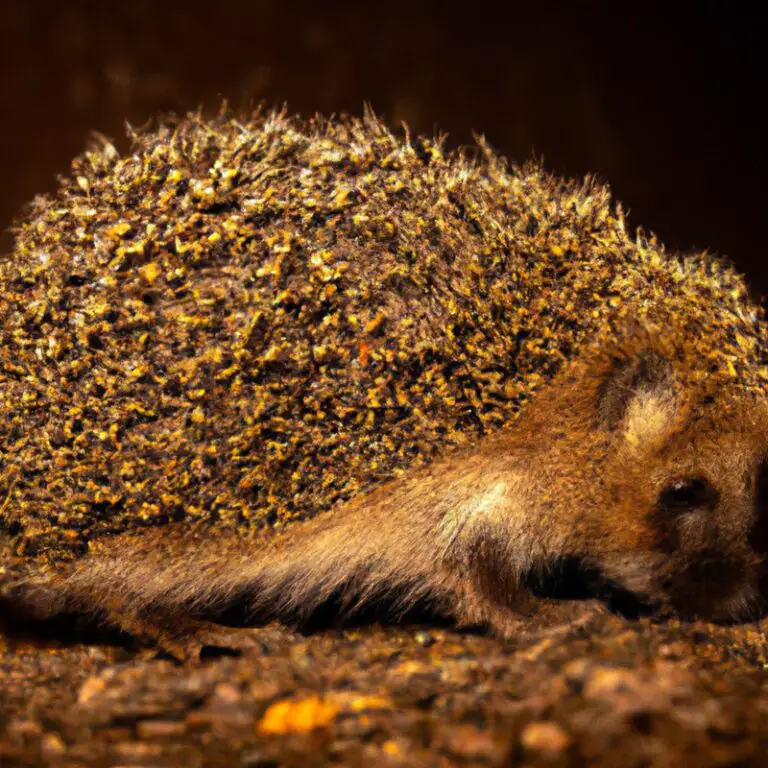How To Prevent Hedgehogs From Drowning In Ponds?
Key Takeaways:
- Create ramps or sloping edges in your pond to provide a way for hedgehogs to escape if they fall in.
- Place rocks or logs near the edge of the pond to give hedgehogs a stepping pathway.
- Avoid using nets or covers that could trap hedgehogs in the pond.
- Ensure the water level in the pond is not too high, reducing the risk of hedgehogs falling in.
Do you love seeing adorable hedgehogs wandering around your garden? Well, here’s something you may not know – hedgehogs can often fall victim to drowning incidents in ponds.
That’s right, those little spiky creatures we adore are actually quite vulnerable to getting trapped in water.
But fear not, my friend, because today we’re diving into this issue and discovering how you can prevent these precious creatures from meeting a watery fate. From creating a hedgehog-friendly pond to maintaining a safe environment, we’ll cover all the essential steps you need to take.
So let’s jump in and make our ponds a haven for hedgehogs!
| Methods | Advantages | Disadvantages |
| Floating Platforms |
|
|
| Ramped Exits |
|
|
| Reduce Pond Depth |
|
|
| Wildlife Friendly Edging |
|
|
Why is it Important to Prevent Hedgehogs from Drowning in Ponds?
Preventing hedgehogs from drowning in ponds is crucial to protect their population and ensure their survival.
The Vulnerability of Hedgehogs to Drowning Incidents
Hedgehogs are vulnerable to drowning incidents due to their small size and inability to swim. Their short legs and spiky fur make it difficult for them to escape from water.
Additionally, hedgehogs have been known to fall into ponds or other bodies of water while searching for food or exploring their surroundings.
It is important to take preventative measures, such as installing ramps or steps in ponds, to ensure the safety of these adorable creatures.

The Role of Ponds in Hedgehog Populations
Ponds play a significant role in hedgehog populations. They serve as a water source for hedgehogs, especially during hot and dry periods when other water sources may be scarce.
Ponds also attract insects, which are a vital food source for hedgehogs.
Additionally, ponds provide a habitat for other small animals and plants that contribute to the overall biodiversity, creating a favorable environment for hedgehogs to thrive. Ensuring the safety of hedgehogs around ponds is crucial to maintaining their population.

Creating a Hedgehog-Friendly Pond
To create a hedgehog-friendly pond, ensure easy access, install ramps or escape routes, and add vegetation and shallow areas.
Ensuring Easy Access to the Pond
To ensure easy access to the pond for hedgehogs, there are a few simple steps you can take.
First, make sure there is a gentle slope leading into the water, allowing hedgehogs to enter and exit easily.
Secondly, avoid any steep or slippery surfaces that may make it difficult for them to climb out.
Additionally, placing some rocks or logs near the edge of the pond can provide hedgehogs with a stepping stone to help them get in and out safely.
Lastly, try to keep the vegetation around the pond trimmed, as overgrown plants can obstruct their path.
Installing Ramps or Escape Routes
One effective way to prevent hedgehogs from drowning in ponds is by installing ramps or escape routes.
These can be simple solutions, such as placing rocks or logs along the edge of the pond to create a gradual slope.
Another option is using commercially available hedgehog escape ramps that attach to the side of the pond.
These ramps provide the hedgehogs with a way to climb out if they accidentally fall in.
Installing ramps or escape routes can make a significant difference in ensuring the safety of hedgehogs around your pond.
Adding Vegetation and Shallow Areas
To create a hedgehog-friendly pond, it’s important to add vegetation and shallow areas. Vegetation, such as floating plants or water lilies, provides cover and places for hedgehogs to climb out if they fall in.
Shallow areas, with a gentle slope and a depth of no more than 4 inches, allow hedgehogs to access water without the risk of drowning.
Keep in mind that hedgehogs are good swimmers, but they can struggle to get out of deep ponds without assistance.
Maintaining a Safe Environment
To keep hedgehogs safe, regularly check the pond, clear debris and clutter, and avoid using chemicals.
Regularly Checking the Pond for Hedgehogs
To ensure the safety of hedgehogs around your pond, it’s important to regularly check it for any trapped or drowning hedgehogs.
Walk around the pond and scan the edges to see if any hedgehogs are stuck or in distress.
If you spot one, carefully use a long stick or net to gently guide it out of the water.
Creating escape ramps or placing rocks at the water’s edge can also help prevent hedgehogs from falling in.
Remember, a quick check now and then can make a big difference in keeping these adorable creatures safe.
Clearing Away Debris and Clutter
To prevent hedgehogs from drowning in ponds, it is essential that you clear away any debris and clutter around the area.
This includes removing fallen leaves, branches, and any other objects that could potentially block their path or create obstacles.
Additionally, make sure to trim overgrown vegetation and maintain a clear space around the edges of the pond.
By keeping the area clean and tidy, you can create a safer environment for hedgehogs and reduce the risk of accidents.
Avoiding the Use of Chemicals
Using chemicals in your garden can harm hedgehogs and other wildlife. Instead, opt for natural alternatives to control pests and weeds.
Regularly remove any litter or debris that may have come into contact with chemicals.
Consider implementing companion planting and biological controls to maintain a healthy and balanced ecosystem. Additionally, provide hedgehog-friendly habitats and access points to avoid the use of chemicals altogether.
Spreading Awareness and Encouraging Others to Take Action
Spread awareness about hedgehog drowning in ponds and motivate others to take action by sharing stories, pictures, and information on social media and online platforms.
Educating Neighbors and Local Communities
Educating neighbors and local communities about preventing hedgehogs from drowning in ponds is essential. Here’s how you can raise awareness:
- Share information: Create flyers or posters with facts about hedgehogs and the importance of providing safe access to water. Distribute them in your community.
- Organize workshops: Host workshops or talks where experts can share tips on creating hedgehog-friendly ponds and gardens. Invite your neighbors and community members to participate.
- Social media campaigns: Utilize platforms like Facebook or Instagram to spread the message to a wider audience. Share photos, videos, and helpful tips to engage people.
- Collaboration: Work together with local wildlife rescue organizations or environmental groups to organize awareness campaigns or events. Their expertise and resources can amplify the impact.
- School involvement: Reach out to schools and offer educational presentations about hedgehogs and their habitats. Encourage students to take initiative and share what they’ve learned with their families.
- Word of mouth: Talk to your friends, family, and neighbors about the issue. Explain how simple changes, like installing a ramp or slope in ponds, can make a big difference in saving hedgehogs.
By educating and involving your neighbors and local communities, you can foster a collective effort to protect hedgehogs from drowning in ponds. Together, we can make a positive impact and ensure their safety.
Sharing Information on Social Media and Online Platforms
One way to help prevent hedgehogs from drowning in ponds is by sharing information on social media and online platforms. By raising awareness about the issue, you can educate others and encourage them to take action.
Use eye-catching images, compelling stories, and clear instructions on how to create hedgehog-friendly habitats.
Also, share tips on pond safety, such as adding ramps or floating objects to help hedgehogs escape. Together, we can make a difference and protect these adorable creatures.
Volunteering and Supporting Hedgehog Conservation Organizations
To support hedgehog conservation organizations, you can start by volunteering your time.
This can involve activities like helping with habitat restoration, organizing awareness campaigns, or participating in rescue and rehabilitation efforts.
Another way to contribute is by making financial donations to these organizations, which can be used for research, education programs, and conservation initiatives.
Additionally, you can spread awareness about hedgehog conservation by sharing information through social media, organizing local events, or even starting your own fundraising campaigns.
Every effort counts in protecting these adorable creatures!
Frequently Asked Questions (FAQs)
Are hedgehogs good swimmers?
Hedgehogs are not good swimmers. Unlike other animals, they don’t have the natural ability to swim for long periods of time.
Their short legs and quills make it difficult for them to stay afloat in water.
If a hedgehog ends up in a pond or any body of water, it can easily become exhausted and drown. It is important to make sure that your outdoor ponds are hedgehog-friendly by providing easy escape routes such as ramps or shallow areas.
Can hedgehogs climb out of ponds on their own?
Hedgehogs are not strong swimmers and may struggle to climb out of ponds on their own.
Their short legs and spiky bodies make it difficult for them to escape from water.
If a hedgehog falls into a pond, it is important to provide them with assistance to prevent drowning.
Creating an escape route, such as placing a ramp or incline, can help hedgehogs climb out of ponds safely.
Regularly checking your pond and ensuring it has suitable exits will greatly reduce the risk of hedgehogs drowning.
Are there any other potential dangers to hedgehogs in ponds?
Hedgehogs face other potential dangers in ponds besides drowning.
They may get trapped in steep-sided ponds without a way to climb out.
Pumps and filters can harm them if not properly covered or secured.
Chemicals used in pond treatments can also be toxic to hedgehogs if ingested.
Dense vegetation near the pond can prevent hedgehogs from accessing an exit.
It’s essential to create escape routes, secure equipment, avoid harmful chemicals, and maintain clear paths around the pond to protect hedgehogs.
Final Verdict
Preventing hedgehogs from drowning in ponds is crucial for their survival and the overall health of hedgehog populations. By creating a hedgehog-friendly pond with easy access, ramps or escape routes, and vegetation, we can provide a safe environment for these adorable creatures.
Regularly checking the pond, clearing debris, and avoiding chemicals will aid in maintaining their safety.
Furthermore, spreading awareness through education, social media, and supporting conservation organizations can inspire others to take action. Let’s work together to protect hedgehogs and ensure their well-being for generations to come.








